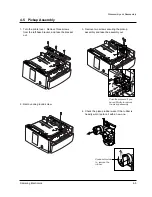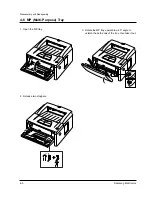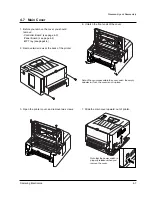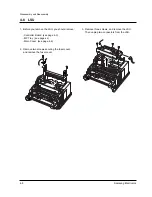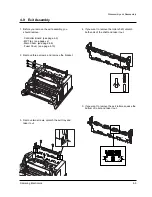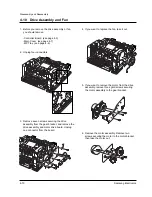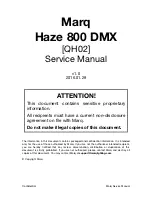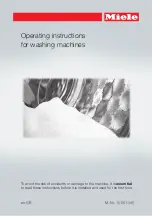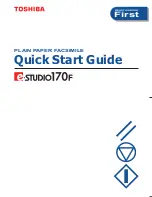
3-2-1 Precautions for Chip Replacement
1. Do not directly touch any portion of the part with
the soldering iron. ICs, especially TSOPs, are
easily damaged by heat.
2. Use care with the soldering iron tip and avoid
rapidly heating parts. Some parts can be damaged
by sudden heating. Preheat the part at about
100
o
C for several minutes before installing it.
3. Use a soldering tip temperature of about 240
o
C.
For larger parts, use a slightly higher temperature
(about 280
o
C).
4. The thin (0.3mm) solder for miniature parts does
not contain adequate flux. Supplementary flux is
thus needed in most cases.
Computer, OA and A/V systems are manufactured
using flux which can be cleaned by water. When
you replace the part or when troubleshooting, use
proper flux and solder which can be cleaned by
water.
Improper flux may cause the soldering area to
corrode and may cause a fatal system error.
5. Use care not to damage the circuit pattern,
especially when desoldering. Because of the many
pins, cleanliness of the pattern is extremely
important after removing an IC.
6. Use care to avoid solder bridges. Remove any
bridges that occur.
7. Position the part carefully. This also affects the
soldering operation. Be very precise in positioning
the IC. Soldering opposite pins first holds the IC in
place and makes soldering the other pins easier.
8. Do not reuse removed parts.
9. Clock for solder joints, especially miniature parts
with small lead.
10. A defective trimming resistor cannot be adjusted
externally. Replace with an ordinary variable
resistor.
11. Always inspect the work with a magnifying lens.
Check after installing cold solder joints, etc.
3-2-2 Tools for Chip Replacement
The tools for chip replacement are as follows:
· Thin tip type soldering iron.
· Small flat-blade tip type soldering iron
· Special desoldering tip iron
· Air-blower Unit
· Flat Package Pick-up
· Flux that can be cleaned by water
· 0.3mm thin solder that can be cleaned by water
· Desoldering wire
· Tweezers
3-2-3 Chip Resistor and Chip Capacitors
TYPES
The types of chip resistors and chip capacitor are as
follows:
· Thick Film Chip Resistors
· Carbon Film Chip Resisters
· Metal Film Chip Resisters
· Chip Ceramic Capacitors
· Chip Trimming Resisters
REMOVING
1. Using Two soldering irons:
a. Use thin tip soldering irons
b. Use soldering tip temperature of about 280
o
C.
c. Simultaneously heat both ends of the part.
d. While heating, grasp the part with the tips of the
soldering irons and remove it.
e. Use desoldering wire to completely remove the
old solder from the part location on the board. A
clean pattern for installing the new part is very
important.
Samsung Electronics
3-3
Reference Information
3-2 Chip Replacement (SMD)


















